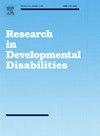The robustness of speech-like vocalization in typically developing infants and infants with autism
IF 2.9
2区 医学
Q1 EDUCATION, SPECIAL
引用次数: 0
Abstract
Background
Human infants produce speech-like vocalizations (“volubility”) at very high rates, 4-5 per minute during waking hours across the first year, far exceeding rates of our ape relatives.
Aims
We document volubility in 127 typically developing (TD) infants, 44 with autism (ASD), and 21 with non-autism developmental delay (DD) through longitudinal recordings and human coding.
Methods and Procedures
Families of 302 infants (110 not yet diagnosed or with other diagnoses) supplied 8.6 all-day recordings across the first year. Trained coders analyzed 21 randomly-selected 5-minute segments per recording, counting speech-like vocalizations, cries, and laughter.
Outcomes and Results
Infants in all groups (including those with other diagnoses or not yet diagnosed) showed volubility of 4-5 per minute for the first year, but boys showed higher volubility than girls in the TD, ASD, and DD groups. While volubility was relatively stable across the first year for both boy and girl TD infants, volubility fell in both ASD and DD boys, while being more stable for girls.
Conclusions and Implications
Strong similarities in volubility were seen across all groups, but male infants diagnosed with ASD or DD showed falling volubility across the first year, a pattern not seen in TD infants.
求助全文
约1分钟内获得全文
求助全文
来源期刊

Research in Developmental Disabilities
Multiple-
CiteScore
5.50
自引率
6.50%
发文量
178
期刊介绍:
Research In Developmental Disabilities is aimed at publishing original research of an interdisciplinary nature that has a direct bearing on the remediation of problems associated with developmental disabilities. Manuscripts will be solicited throughout the world. Articles will be primarily empirical studies, although an occasional position paper or review will be accepted. The aim of the journal will be to publish articles on all aspects of research with the developmentally disabled, with any methodologically sound approach being acceptable.
 求助内容:
求助内容: 应助结果提醒方式:
应助结果提醒方式:


